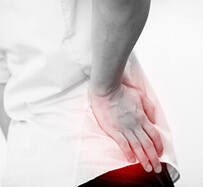Stem Cell Therapy for Hip Injuries San Francisco, CA

Repetitive use. Abrupt falls. Autoimmune disorders. Menopause induced bone density loss. The causes of hip injuries are many, but the pain they cause in our body’s largest ball-and-socket joint effects every patient’s mobility and quality of life.
We provide one of the most potent regenerative treatments known to science: stem cells. When injected directly into injured areas, these stem cells may stimulate your own damaged cells’ regenerative potential to restore your tissue, eliminate your pain, and revive your hip’s range of movement. Depending on factors like age and genetics, the live-nucleated cells we introduce may continue producing human growth factors for weeks, sometimes even months.
To meet with a stem cell therapy provider for hip injury in San Francisco, call (510) 340-9241 or contact Dr. Robert Rowley online.
What causes hip injuries?
The most common hip injuries are caused by osteoarthritis – chronic degeneration of the cartilage that cushions joints, along with fractures caused by weak and brittle aging bones.
Other conditions that can cause hip injuries include:
- overuse of the tendons and hip joints often during manual labor or excessive exercise
- hip labral tear: damage of cartilage surrounding the bony edge of the pelvic socket
- bursitis: swelling and inflammation of fluid-filled sacs that cushion and lubricate joints
- tendinitis: inflammation or irritation of tendons from repetitive stress
- rheumatoid arthritis: a chronic inflammatory joint disease that attacks healthy tissue
- lupus: a chronic autoimmune disease that damages tissue (can cause death of bone cells due to decreased blood flow)
How are hip injuries diagnosed?
Hip injuries can be diagnosed in the following ways:
- physical exam and medical history review
- X-rays to reveal the condition of the bones and hip joints
- CT and MRI scans to analyze soft tissues like tendons and muscles
- blood test to detect levels of antibodies that indicate rheumatoid arthritis and lupus
- arthrocentesis or joint aspiration: hip-joint fluid is extracted for laboratory study
How does stem cell therapy compare to hip replacement surgery?
Hip surgery often requires patients to stay in a hospital overnight for several days and is followed by several months of physical therapy. Patients may not be able to perform certain movements like bending or twisting for up to a year and may no longer be able to do activities like sports, jogging, and dancing.
Stem cells may be able to bypass these issues. While it may take several weeks for your hips to return to full functionality, stem cell therapy does not take away tissue, but rather encourages the growth of new tissue. Stem cells can be used to treat hip arthritis by reducing inflammation and repairing and regenerating the cartilage around the hip joints. Stem cells also have the potential to alleviate debilitating pain and even repair damage caused by conditions like bursitis and osteonecrosis.
How can stem cells regenerate my hip tissue?
In the case of a hip injury, stem cell therapy may help relieve pain and repair damage caused by common injuries and conditions like bursitis, osteoarthritis, hip arthritis, labral tears, and avascular necrosis. Injured tissue cells send out signals, and stem cells respond to those signals and migrate to the injured tissue, releasing proteins that nourish and stimulate your own cells to begin regenerating.
Your specialist will begin by cleaning and numbing the area and using x-rays to guide the needle into the precise injury spot. Once your practitioner injects the cells, they dock next to your damaged cells and release growth factors, cytokines, and chemokines which then may:
- activate T-cells to secrete proteins
- open up your blood vessels and form new ones
- move cells out of your blood vessels and into the tissues surrounding them
- stimulate your cells to regenerate your tissue
- inhibit your inflammation
- regulate your immune system
The whole procedure usually takes less than an hour, and you can return home the same day. You should rest as much as possible for the first 24 hours after your stem cell hip injection. You will need to avoid anti-inflammatory medications and any load-bearing activities for at least two weeks. You can walk and perform cardio usually after about 3-4 weeks and can run and weightlift after about 4 weeks (once your healthcare provider gives the okay).
As with all medical procedures, success rates will depend on your age, body type, genetics, and injury severity.
Where do these live stem cells come from?
We process the umbilical cord blood of healthy newborns. If a pregnant woman scheduled for caesarean section decides she does not want to keep and store her unborn child’s umbilical cord, her OB/GYN will ask if she wants to donate it. After she signs an informed consent form, she undergoes a medical and social history review, as well as blood tests. If the new mother meets all donor eligibility requirements, she is accepted as a donor.
After her baby is born, the umbilical cord blood is collected in a sterile collection bag and sent to a lab. The cord blood is processed within 48 hours using proprietary methods. A sample of the finished product is tested by an independent third-party lab for sterility. Only after all lab reports have passed the regulatory requirements can the umbilical cord stem cells be distributed.
Are umbilical cord stem cells FDA approved?
The FDA recently confirmed there is only one registered and approved stem cell product on the market: umbilical cord blood-derived hematopoietic progenitor cells (blood forming stem cells) used for certain indications. While there is enormous promise in stem cell therapies, and thousands of ongoing experiments trying to establish efficacy, stem cell treatments do not yet meet the FDA’s scientific approval standard.
Practitioners tapping into this enormous promise of stem cells for any therapeutic use must exercise their professional judgment and expertise. We urge anyone embarking on the use of stem cell therapies to consult the national health data bases to evaluate current clinical trial information, and the FDA’s website on human tissue, to get its current therapy evaluations.
In 2018 the FDA’s commissioner and research director reported that the agency will be incorporating some “new concepts for how small investigators and firms can seek and meet the approval standard for products through efficient expedited pathways.” You can keep up with latest developments on the FDA’s website.
What are the side effects of stem cell injections for hip injury?
As with any other injection procedure, there is a small risk of bacterial infection (not associated with the product) and nerve damage. If you experience severe pain, bleeding, or swelling at your injection site, or experience symptoms like fever, nausea, dizziness, or vomiting, seek emergency medical care right away.
Reserve Your Appointment Now
A hip injury can seriously dampen your quality of life, but regenerative stem cell therapy can help treat your injuries and revive your lifestyle. To learn more about stem cell therapy for hip joints in San Francisco, call (510) 340-9241 or contact Dr. Robert Rowley online.
Hayward Family Care
Address
27206 Calaroga Ave,Suite 116
Hayward, CA 94545
(510) 340-9241
www.haywardfamilycare.com
Hours
Mon:
9:00 am - 5:00 pm
Tue:
9:00 am - 5:00 pm
Wed:
9:00 am - 5:00 pm
Thu:
9:00 am - 5:00 pm
Fri:
9:00 am - 5:00 pm
Sat:
8:00 am - 12:00 pm
Sun:
Closed





